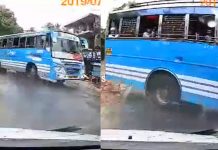Just like humans, animals too use their own ‘roads’ for their regular movement from one foraging or mating ground to another, within and between the forests.
In forests with densely packed undergrowth, animals would need a well-connected trail or path to facilitate their locomotion. Well, this raises the question- who then, designs, constructs and develops a ‘road’ or path in a forest?
The answer is unequivocal! The animal kingdom has its own ecosystem engineers to build its paths- the elephants! Bestowed with magnificent body statures, elephants are capable of moulding and modifying the entire landscape- thus promoting the migration and movement of various animals including big cats, small carnivores and other herbivores.
Private Bus ‘Sangamam’ vs Wild Elephants at Munnar Marayoor Road : VIDEO
Several anecdotes demonstrate that the elephant-constructed paths are used by indigenous folks or tribes for their daily chores and even for building the ‘human roads’.
The elephant-made ‘roads’ too have their intertwined networks. Quite like humans, elephants also have their own ‘national highways’ which connect different habitats and are called ‘corridors’. These corridors are frequently used by the traffic of elephants to move from one forage-rich habitat to another. The ‘state or village highways’ are designed digitately to connect different water-holes, pockets of forests and salt licks.
One of the major negative interactions between humans and elephants originates from the human-made highways crisscrossing the elephant highways. These roads are important to both the species for their respective quests.
Several national highways in India traverse through different National Parks and elephant habitats. The fatal consequences of constructing these metal roads by cutting forests are not limited to just elephants; they are distorting the food-web by smearing lower-taxa on the roads to sending ruptured bones of carnivores flying into the air.
What makes this issue even more serious, however, is the involvement of elephants. High cognitive capabilities, strong social bonds and long-term memories do not just add to elephants’ uniqueness, but also make them more vulnerable to harm by human activities. When viewed from an elephant’s eye, they have been using the same routes or corridors for centuries, with no other alternatives to reach other forests or habitats either to forage, to find water or to congregate and meet their conspecifics.
On their way, they attempt to cross man-made roads and this is not only risky but can also turn fatal. If the road crossings are mistimed, then they could potentially collide with speeding vehicles, resulting in injuries or even death. Hence, such demises or road-killings can leave an irreversible imprint on their minds, causing traumatic stress, which could be harmful to both elephants and humans.
1. Pause your vehicle at least 30 metres apart if spotting a wild elephant crossing the road. If the wild elephant walks closer, shift your car in reverse gear, maintain your composure and drive off slowly. Wait patiently until the beast walks off the road and start to drive pass.
2. Don’t blow the horn or make any noise to disturb the elephant as the noise could enrage and stimulate it to charge at as its ears are sensitive to the horn tweeters.
3. Don’t photograph the beast with flash on as it could frighten and turn it to charge, or arose its interest to come closer to explore.
4. Always keep the car engine on so as to turn back in time if the elephant walks closer. The bass noise of the engine will not disturb or frighten it as it is familiar with such noise from vehicles and it is not interested in it.
5. In case of driving at night and encountering elephant, always keep the headlights on and try to observe its signs and keep a distance from it. Don’t flash the lights as this could draw its attention and walk up to the vehicle.
Our aim should be to reduce negative interactions with elephants and to facilitate their fear-free movement. Blaming each other or the authorities only results in creating ripples in society and certainly is not helping these gentle giants. As a passerby, showing respect and basic etiquette towards the road-crossing elephants would not only reduce fatalities but would also satisfy us as a responsible onlooker. Now it’s upon us to decide whether to honk and shout at elephants or to let them move peacefully on roads most travelled by.



















